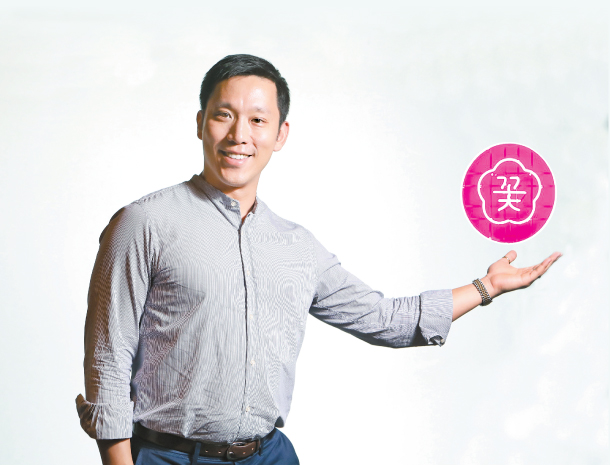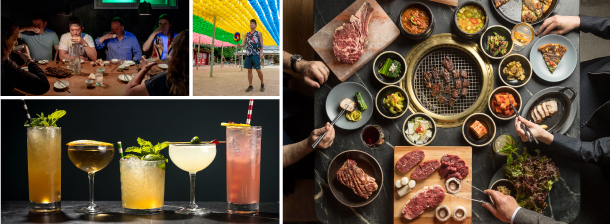A visit to Korea to understand Cote’s roots: Restaurateur Simon Kim reflects on bringing his team from the New York hot spot to Seoul

Simon Kim, the proprietor of Cote, is always ready to welcome customers. The pink neon logo is what customers see when they step inside the restaurant. [PARK SANG-MOON, COTE, GARY HE]
Simon Kim, who owns Cote, came to Korea last month with a team of leaders from his restaurant. The goal of the trip was to help the crew understand where the concept of a Korean steak house in New York comes from. They not only visited a number of popular restaurants to learn more about the local food scene here, but the Cote also hiked up Mount Bukhan in northern Seoul and headed out to the beaches on the east coast to immerse themselves in nature, as well as experience hanok (traditional Korean homes) and study architecture to see how Korean people have developed their own artistic styles.
How is Cote different from other Korean barbecue spots in New York? Kim planned to bring out the “authentic” taste of Korean food while adding other services that could make the “authentic” experience more fun.
To better cater to the tastes of New Yorkers, who are known to enjoy great cocktails and wines, he set up a strong beverage menu ranging from cocktails and wine to Korean liquors to make his restaurant somewhat unique while, at the same time, comfortable. At Cote, people can enjoy Korean dishes with their favorite drinks that they rarely find at restaurants in Manhattan’s Koreatown neighborhood.
Kim calls his restaurant a Korean steak house rather than a Korean barbecue restaurant to signal a subtle but very big difference.
“We didn’t want the ‘authentic’ version of the Korean barbecue,” said Kim, “because I didn’t want the restaurant to be the best second place,” as he was explaining that he needed to create a new concept from the already existing and popular style of Korean barbecue in order to stand out from the overflowing waves of such spots in Korea and elsewhere in the world.
“As a Korean-American, I have seen what’s good in both cultures as well as what lacks, and I wanted to adopt what’s better in each culture, and marry them together to make something that resonates well to many. We don’t promote it as a Korean restaurant in New York. It is a restaurant in New York that serves Korean food.”
The restaurant’s other strength is that customers can try a variety of meats in one sitting instead of being stuck with only one big chunk of beef. And while your steak might get cold as you eat it at any other steak house, the meat at Cote is always at the best temperature thanks to the trained staff who grill your meat right at your table.
“The last bite of the steak is equally great as your first bite,” said Kim.
Kim has inspired many chefs to focus more on the fun they can have with Korean barbecue, and many Korean-Americans in the culinary industry, including some chefs at Michelin three-starred restaurants, are now gearing up to open their own Korean barbecue restaurants.
To learn more about what Kim, who started his career in the service industry at age 16, has created in New York, the Korea JoongAng Daily recently sat down with him for an exclusive interview. The following are edited excerpts from the interview.

Clockwise from top left: A team from Cote, a Korean steak house in New York, try makgeolli, a fermented rice drink, during their visit to Korea last month. They also visited temples and other cultural spots to learn more about Korean culture. A table top at Cote shows features a wide array of food. The cocktails available at Cote appeal to local tastes. [COTE, GARY HE]
A. Serving Korean barbecue was not something a chef would do. It wasn’t considered something that could make an impact in the market. The success of Cote has shown how imagination can lead to possibilities. It is a very positive sign that many see the emergence of Korean barbecue and more are joining in. Just like sushi restaurants in New York compete with one another, which results in the [high quality] of sushi spots in New York, the same could go for the Korean barbecue. We will make sure that we stand out as the first Korean steak house in New York and highlight our unique angle with a balance between Korean and American cultures. [Being good at what we do] isn’t always about doing new things. It is about doing things a little better with a warmer smile. I am not a chef. As a restaurateur providing what customers want and allowing chefs to do want they to do at the same time are important. I want something a little more comfortable and a little more accessible for all.
How did you train your staff to grill the meat right at the customers’ tables?
It was all me in the beginning teaching the staff how to grill and another Korean manager, who has been promoted to a service director. Now we have a monthly grilling class that’s about an hour and 30 minutes long. We talk about technical things, such as what part of beef has more juice and how to retain that juice. We talk about how muscle tissues are structured and knowing that is crucial when cutting in order to keep the most juice inside. Some of the servers used to be chefs. As they grill, they explain the different parts of meat. And they say the Korean name for each part as well.
What was the purpose of your trip to Korea?
This trip was more about team building. No one works as hard as we do as one team. What I’m most proud of is the team. It wasn’t an easy trip to plan, but I wanted to show these people who work for a restaurant that serves Korean food what is Korean. I wanted them to see what they can be genuinely proud of. I introduced them to mentors and supporters of the restaurant. And many of them said thank you to my team, saying that what they are doing for Korean culture is something they are grateful for as Koreans. My team probably didn’t [understand] why they are being thanked because they just work to do a good job. But to Koreans, the team is executing the dreams of many Koreans, who want to spread the word about Korean culture. Besides that, they also got to learn the context behind a lot of Korean food culture. They [got to see] in what context people drink soju when eating food and why people wait in line for a bowl of naengmyeon (cold noodles with broth). Training the team will result in showing customers [in New York] Korean culture in a meaningful way, and the team members become ambassadors. They got to see “Korean hospitality.”
What are your thoughts on Korean hospitality?
I think two different things make up Korean hospitality. One is a little more jeong driven. (Jeong is a Korean word indicating care and love shown to people who you know or don’t know.) It is like you go into a mom and pop and feel like you have become a member of the owner’s family because they will check on your food and ask whether you want more soup or you can go get your own food from the kitchen. That is the sort of human angle. At the same time, Korean hospitality has a very professional aspect to it as well. The concept of “Customer is the king” is widespread and, historically, there has been a saying, “we are here to serve you.” That kind of ultimate hospitality shows you are factually above me, and I’m below you to serve you. I think this aggressive level of hospitality is great. There shouldn’t be any sort of a pride involved. When I greet customers, I’m not Simon Kim but a manager of Cote who is there to serve. By knowing what angle of hospitality you take, then you can channel that and serve customers in a way you think is professional.
What is Cote to you?
Cote is extremely fun. It represents me personally. I’m a hybrid of both Korean and American culture.
Are you thinking about opening more restaurants soon?
Can you guess where? It’s a little south of New York. [We will be opening a restaurant] in Florida in September next year. The city is a great market yet there are very few Asian restaurants. It is an uncharted territory for a Korean steak house so it’s a good market to put a Korean flag down in. What we will do there will be very similar to what we do in New York, but there will be some changes and adaptations to make the food more compatible with southern American-style food. Mulhoe (a raw fish bowl served in sweet and sour flavored soup with vegetables) is a typical seafood dish in Korea, and that can be an inspiration behind making ceviche. I’m not trying to recreate any cuisine but thought it’s important to show customers there that the restaurant considered the [tastes] that locals there are comfortable with.
What’s your goal as a restaurateur?
I think I have two goals. As a Korean-American and as a human, I would want to continuously push Korean culture and share that with the world. I started doing that with beef, but there was more that I could do. Another goal is to utilize the platforms I have built to continue to present the cultures right.
What advice would you give to aspiring restaurateurs hoping to make it work in New York City or elsewhere?
There’s reason why people say if you make it in New York, you make it anywhere. New York City is the most difficult place to make it work. Everybody thinks they do what they want to do yet rarely try to study New Yorkers and whether the people there are willing to accept what you want to do. Without understanding New York, thinking about trying to make it only gets people overly excited. I recommend studying.
BY LEE SUN-MIN [summerlee@joongang.co.kr]










with the Korea JoongAng Daily
To write comments, please log in to one of the accounts.
Standards Board Policy (0/250자)